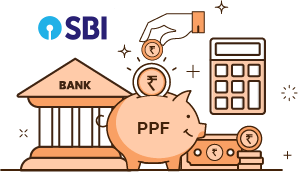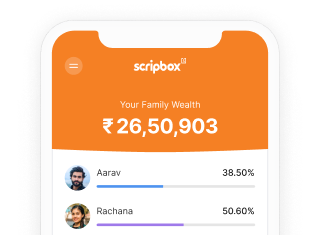SBI PPF Calculator: Calculate Your SBI PPF Returns Online
SBI Public Provident Fund (PPF) is a Government-Backed Scheme launched by the National Savings Institute. The interest on PPF is announced every quarter by the Ministry of Finance. For the current quarter SBI PPF interest rate is 7.1%. Interest and wealth accumulated on PPF can be estimated using SBI PPF Calculator.
What is SBI PPF Account?
Public Provident Fund (PPF) is a long-term investment saving scheme that offers several benefits to investors like Government-backed returns, benefits under the Income Tax Act, loan facility, partial premature withdrawal, etc. Investors use it to build their retirement corpus by contributing a fixed amount every month or in lump-sum. PPF has a 15-year lock-in period.
PPF works on an Exempt-Exempt-Exempt (EEE) tax-saving model. The contribution made by the investors is allowed as a tax deduction under section 80C of the Income Tax Act. Furthermore, the interest earned and the maturity proceeds are also exempt from tax at the time of withdrawal.
SBI PPF Interest Rate 2025
The PPF account interest is paid on the amount standing in the investor’s account. The PPF rate of interest is reviewed by the Ministry of Finance. The Government of India revises the PPF interest rate every quarter and over the past several years the return has been witnessing a downtrend. The current SBI PPF interest rate is 7.10% p.a. for July 2025.
How to Use Scripbox’s SBI PPF Calculator?
Our SBI PPF account calculator is an online tool that provides an estimate of interest earned, maturity value for a given amount invested and investment period. An estimation of the total corpus created at the end of the investment period helps you know whether the investment option chosen matched with your financial goal or not.
Steps to use the online SBI PPF returns calculator:
- Visit our website.
- Enter the amount to be invested.
- Enter the period of investment.
- Once the above details are entered, the SBI PPF returns calculator will provide you the total corpus created at the end of the investment period.
Example
Mr. Arun wants to estimate the maturity amount for his yearly investment of Rs 25,000 for 15 years
He can quickly get an estimate by using our SBI PPF calculator 2025. The estimated maturity amount is Rs 733,107 and wealth gained is Rs 3,58,107
How Does the SBI PPF Calculator Help You?
As per PPF rules, the investors can make an investment of a minimum Rs. 500 and up to a maximum of Rs. 1,50,000 in a year and claim the tax benefits for the same.
The investment can be made either monthly or in a lump sum. SBI PPF calculator helps you to estimate the returns according to the amount invested by you and the lock-in period selected by you. Accordingly
Following are a few benefits of the SBI PPF calculator:
- Enables you to evaluate various cases with the change in investment amount.
- Shows you the total invested amount according to the tenure.
- It shows you the total interest earned after maturity.
- Displays the total amount you will receive after the account matures.
List of PPF Calculators by Banks
- HDFC PPF Calculator
- SBI PPF Calculator
- Post Office PPF Calculator
- ICICI PPF Calculator
- PNB PPF Calculator
- Canara Bank PPF Calculator
- BOB PPF Calculator
- BOI PPF Calculator
- Axis PPF Calculator
Frequently Asked Questions
Both the investment options in SBI differ substantially, and has their own set of benefits and feature
The lock-in period for SBI PPF is 15 years where as SBI FD tenure ranges from 12 to 60 months. Bank FD provides a flexibility to choose the investment period. The SBI PPF interest rate is set by the Government and SBI FD rates are set by the bank .
When it comes to flexibility, SBI fixed deposit provides a better investment option. However, that depends on the investment goal, financial objective and investor’s preference. Read more in PPF Vs FD
To check your SBI PPF balance, the account holder must have an internet or mobile banking activated for your saving account. The account holder can view the SBI PPF balance by simply logging into your saving account.
SBI PPF calculator is an online tool that helps you in estimating the returns on the basis of the minimum amount invested. It shows the total investment made, interest earned and the maturity amount at the end of the maturity period. You need to submit the documents required for your address proof and identity proof like aadhar card, PAN card etc
PPF scheme falls under the EEE (Exempt, Exempt, Exempt) tax exemption category. This means a contribution made is allowed as a tax deduction under section 80C of the Income Tax Act. The interest earned thereon is exempt under section 10(11) of the Act. You can use Scripbox’s Income Tax Calculator to estimate your total taxable income after claiming tax exemption of PPF investment
Investors can avail loans against PPF accounts in SBI between the 3rd and 6th financial years from the date the account was started. Partial PPF withdrawal is allowed subject to certain conditions.
SBI PPF account comes with a mandatory lock-in period of 15 years. Partial PPF withdrawal is allowed subject to certain conditions but closing the account completely is not allowed before the completion of maturity period.
it is not mandatory to make investments in SBI PPF account every year. How ever a long-term investment option can helps the investors to maintain a retirement corpus and also provides tax benefits under section 80C of the Income Tax Act.
You can make an investment in the SBI PPF account either monthly or a lump sum amount. In order to claim the full interest and high PPF maturity, it is required to make the investment before 5th of the month.
PPF scheme and Sukanya Samriddhi Yojana, both are government investment schemes meant for long-term investments. Both schemes have similarity w.r.t. Long term options, tax exemptions and backed by the Government. There is a basic difference between both schemes. SSY is meant for securing your girl child’s future and PPF is meant to build your retirement corpus


